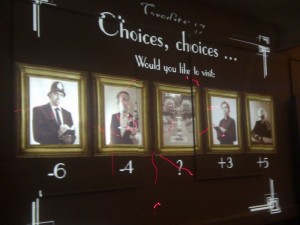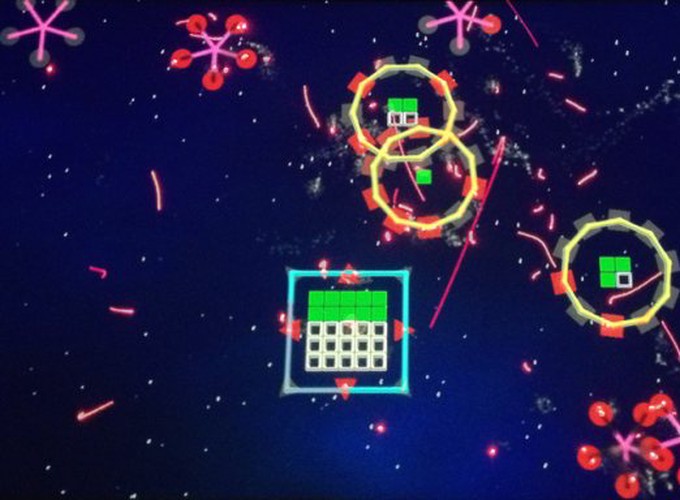[renga] is about finding a way home. Attacked and left for dead, our hero must carefully marshal their resources to build a new ship, confront their nemesis and finally return home. Only this hero isn’t visible on the screen - it’s the entire audience, working collectively to control the action using laser pointers directed at the screen. Turning the traditional hero’s journey on its head, [renga] asks the question - what if the ultimate reward can only be grasped by many hands? The show combines real-time crowd interaction technology, retro videogame aesthetics and a wry sense of humour to bring the audience together and leave them feeling a deep sense of camaraderie.
[renga] is a large, unique experience that won a number of awards (including the prestigious Indiecade 2012: Developer’s Choice Award) and highlights my early movement from a commercial game developer into a digital artist. [renga] was created in 2011 in collaboration with Adam Russell and is still talked about as significant work in the world of large group interactive experiences. We had great interest from North America and many of performances took place at festivals across the United States of American and Canada.

[renga] is an interactive, cinematic game that mixes new technology, adventure and a wry sense of humor to turn the traditional hero’s journey on its head. [renga] is a giant co-operative game in which up-to 500 simultaneous players interact with a large projected image using laser pointers. The title refers to a form of collaborative poetry with 100 verses that blossomed in 15th century Japan. We’ve built a custom hardware setup using an HD camera and multiple networked machines. We capture video of the screen, analyse this on the first machine and then send data to the game machine as a kind of multi-touch input.
The game rewards coordinated movement of laser pointers but allows formations to emerge without advance planning as players observe other points of laser light and join groups as they appear. A typical game lasts ~60 minutes. As this is a live event experience, a Game Jockey or “GJ” is able to adapt parameters on the fly in order to moderate the pace and difficulty to the live audience. Performances of [renga] are still requested and prior to COVID [renga] was shown a handful of times every year in both public and private events.

At the time we built a number of different experiences using our novel laser pointer system. These were our favourites:

Murder Mystery
 |
The Mystery of the Disappearing Diamonds is a whodunnit game for several dozen players, typically lasting around 20 minutes. Lady Wadham has been murdered and her precious jewels stolen. The audience must find ways to bribe the butler, piece together what he has seen or heard and solve the mystery before the police. Along the way you’ll explore the grounds of the manor, test your knowledge of classic mysteries, and be rewarded for your honesty in revealing surveys. The audience will laugh, cheers and applaud as they solve the crime together. |
Jigsaw
 |
With this work the humble jigsaw is no longer a dusty old collection of cardboard pieces you find in a battered box at your holiday home, which you painstakingly assemble only to find several pieces are missing. Instead, this is the jigsaw reborn as a giant collaborative wall projection. Suitable for up to 20 simultaneous players, the jigsaw images can be easily customised for different events. Can be used for a short 10-minute introduction, or run as an automated series of images in the background of a longer event. |
Particles
 |
Particles is an ambient installation for up to 100 players. Players must work together to trigger visual effects, with larger groups of players able to achieve larger effects on screen. There is also a positive feedback loop for overall engagement, so that as the audience becomes more engaged, they are presented with a wider variety of effects. This interactive wall was developed to support the Charity Shop DJ party held at Derby Silk Mill, and was designed to complement the industrial environment and to echo the 70s theme to the party. The interactive wall was repeated several times throughout the museum space so that the effects generated were reflected over the dance floor. |
